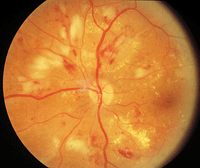Blacks are more likely to develop diabetic eye damage at lower blood glucose thresholds than whites, according to a recent study in the Annals of Internal Medicine. The results suggest that black people may be more vulnerable than whites to high HbA1c levels.

Blacks may be more vulnerable to higher HbA1c levels, and thus at greater risk for diabetic retinopathy.
Researchers at Beth Israel Deaconess Medical Center in Boston evaluated the association between elevated HbA1c levels and the risk for retinopathy development using National Health and Nutrition Survey data from 2,804 whites and 1,008 blacks.
“We looked at the data to determine if a higher diagnostic cutoff of A1c level should be used to diagnose diabetes in blacks than in whites, or if there should be a single cutoff for all races,” said lead author Yusuke Tsugawa, M.D., M.P.H.
The World Health Organization and American Diabetes Association have recommended that an HbA1c level of 6.5% is diagnostically significant for diabetes, compared to an HbA1c level of 5% in healthy individuals. Given the evidence of inherently elevated HbA1c percentages in blacks, the researchers initially hypothesized that diabetic retinopathy would begin to manifest at proportionately higher blood glucose levels.
However, the evidence indicated that the exact opposite was true. They found the risk of diabetic retinopathy is higher for blacks at HbA1c levels between 5% and 7%. In fact, the higher risk at an HbA1c level of 5.5% to 5.9% for blacks was comparable to the risk at an HbA1c level of 6% to 6.4% for whites.
“This indicates that black people may be more vulnerable to high A1c status than whites,” Dr. Tsugawa said.
He added, “It may be appropriate for doctors to more closely monitor for early diabetic complications for their black patients than for their white patients, and black patients with diabetes may benefit from retinal exams at an earlier stage of their disease.”
Further research may be able to confirm whether blacks should have a lower diagnostic threshold of HbA1c than whites, the authors concluded.
Tsugawa Y, Mukamal KJ, Davis RB, et al. Should the hemoglobin A1c diagnostic cutoff differ between blacks and whites? A cross-sectional study. Ann Intern Med. 2012 Aug 7;157(3):153-9.

